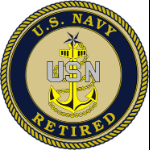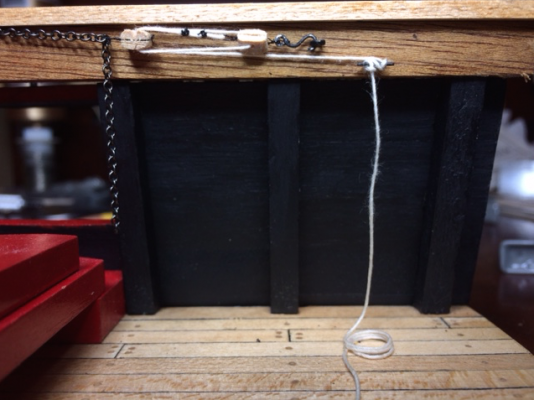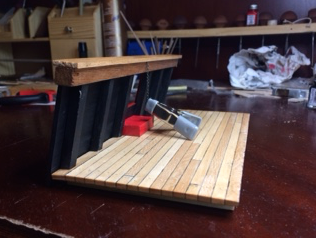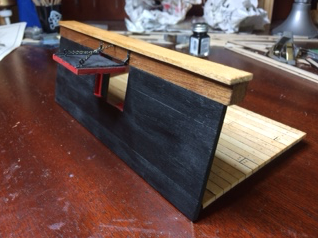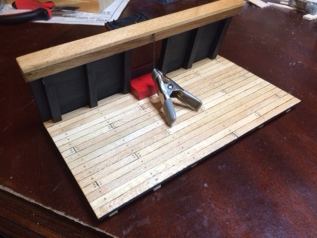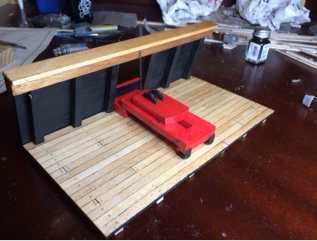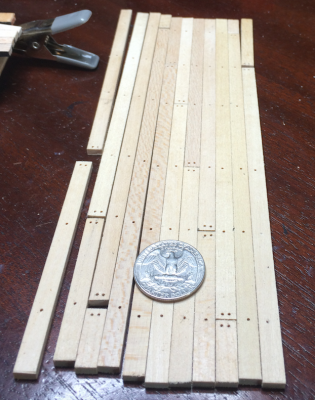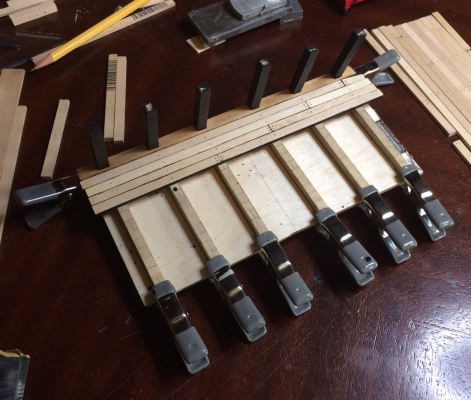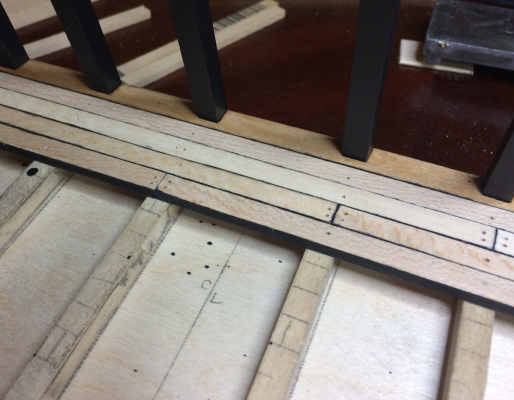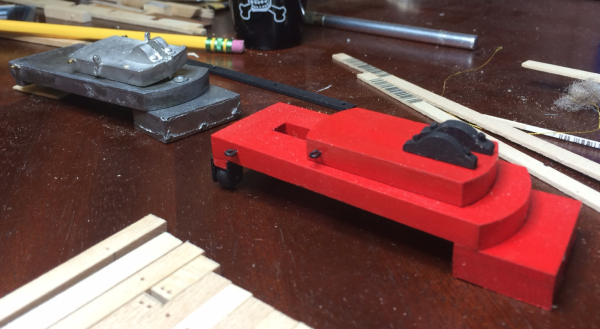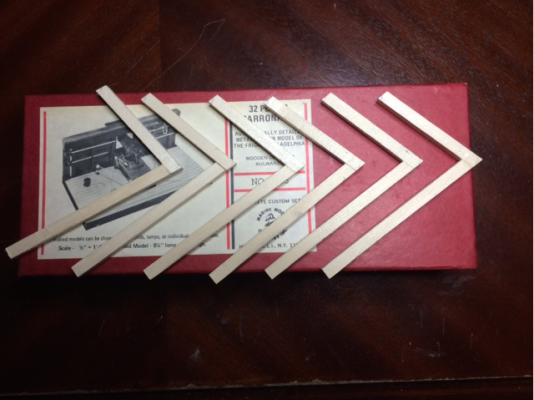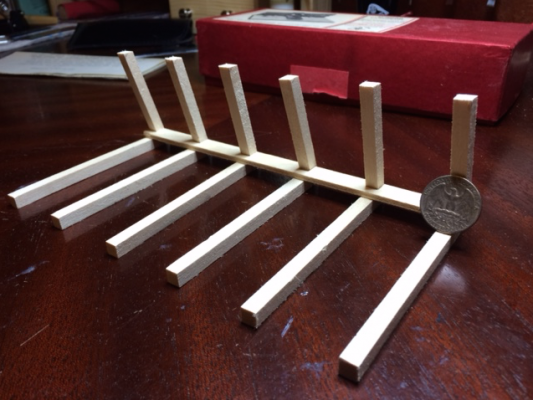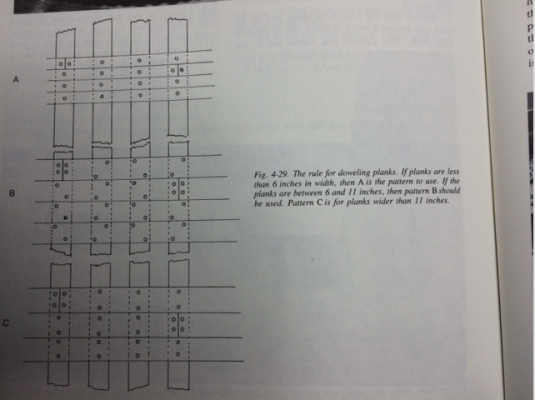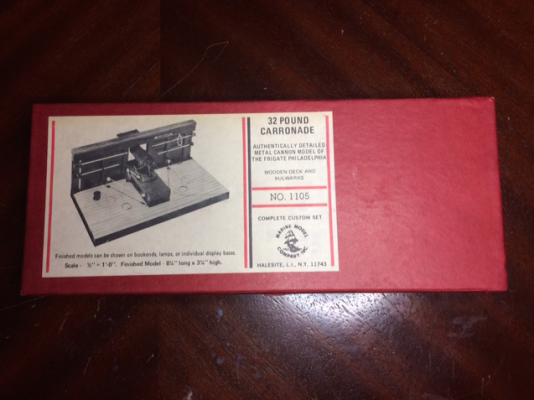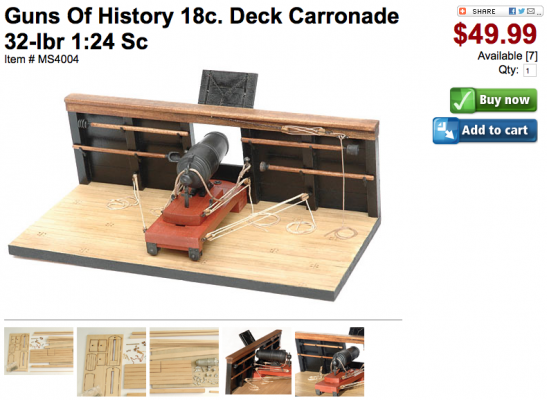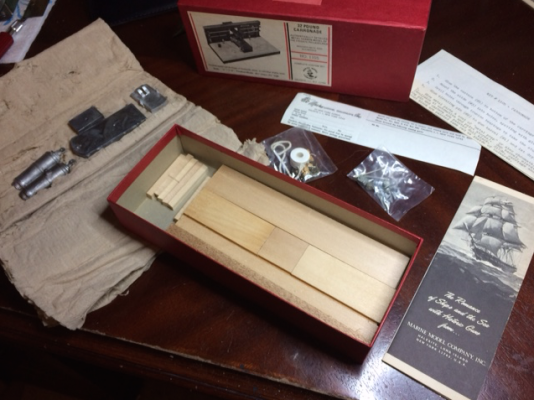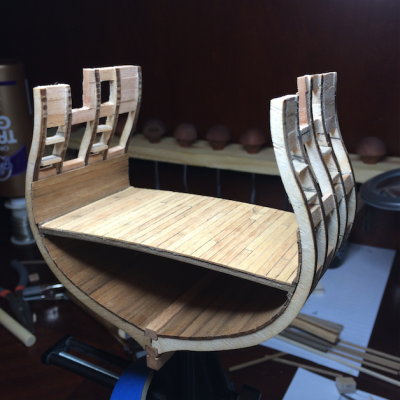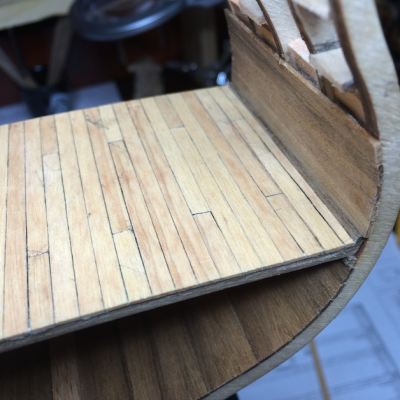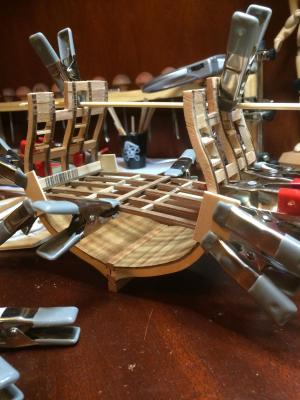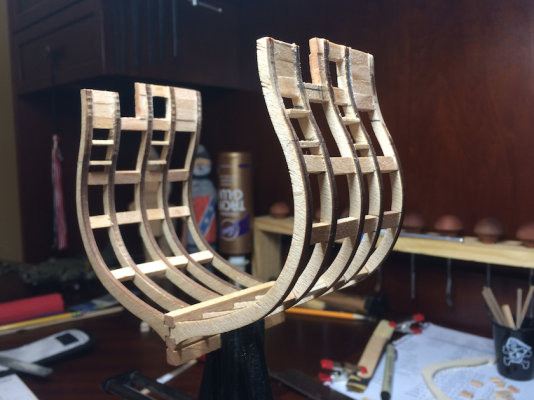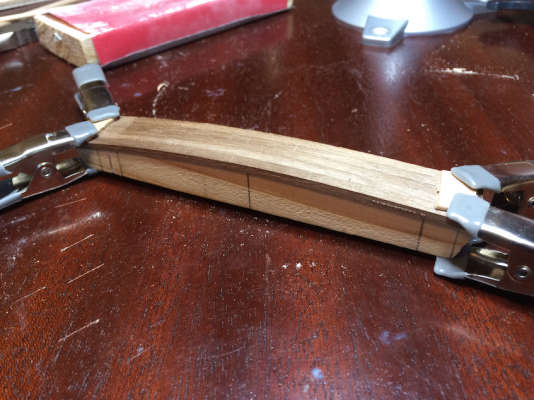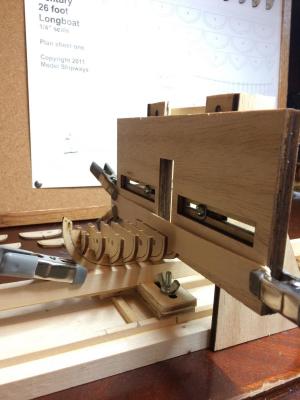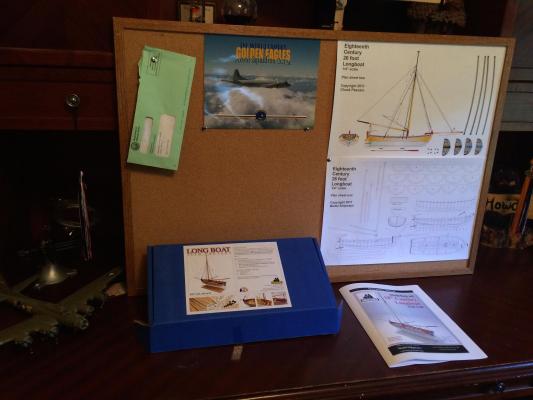-
Posts
47 -
Joined
-
Last visited
Content Type
Profiles
Forums
Gallery
Events
Everything posted by Stubby
-
I have a Syren in the box for a future build - I'm definitely learning a lot from your log and enjoying your mods and ingenuity! - Stubby
- 1,306 replies
-
- syren
- model shipways
-
(and 1 more)
Tagged with:
-
Attached the gunport tackle today. The blocks that came with the kit were too brittle, so I made new ones. I'm not completely happy with the hook - which I fashioned out of wire, and the eyes - which I made out of black thread which was really too thin for the task. I haven't cut the chain yet just in case I want to redo it. I doesn't look bad; I think I'll sleep on it.
-
So, I haven't been very chatty about my progress, but have been progressing none the less. I installed the hull planking, cap piece and rail cap, and am pretty happy with it. I decided not to use tunnels on the hull planking - mostly because I was being lazy, but also because I wasn't sure if they would show up under the black paint. Looking at it now, I think they probably would - but I can live with it. I also put together and attached the gunport lid. I made a few minor mistakes as I went through, but I don't think they are too noticeable. The next step is to install the block system that raises the gunport lid. I also need to start prepping the actual carronade. I've been putting that off because it came so rough. The last picture shows the carronade base. Not yet installed - just sitting there so I can pretend I'm farther along....
-
So it's been quite a while since I last posted an update - been a crazy busy couple of months. I have however, don a little work on this model. I measured out the deck planks and drilled the holes for the tree nails. I am painting the edges of the planks to simulate caulking. I tried the pencil trick with my other model, and while a generally liked the result, it was kind of messy. So... giving the paint approach a try.... The photos show the progress. None of the planks are glued in place yet. I plan to paint the caulking on all of the planks and then glue them in place. Then I will make and install all of the tree nails and sand and stain the entire deck. I'd welcome any constructive advice along this lines, as I have never attempted it before. I also recreated the carronade platform out of wood, because I thought it would look better. Not done yet, and not perfect, but I am generally happy with the results.
-
One thing I didn't like about the older model kit was that there is no planking; the deck is a block, and the directions call for "scoring" to mimic the deck plates. So for that reason I decided to build the platform (at least) from scratch. So instead of a solid base, I went and bought some wood for beams and planks. The kit included 1/4" x 1/4" pieces for the timber heads, so I made the beams match. The directions called for "scoring" to be every 1/4", so I got 1/4" planks. I cut the beams and timber heads yesterday and fussed with them for a while. The pivot block in the kit is cast metal, but in the modern kit it is wood. I liked the wood version better - and think it's more accurate - so I reproduced it from some scrap wood. The pivot block is 5/8" x 1 1/4", the latter being the spacing between the timber heads (and consequently the beams). I also constructed a waterway, which isn't mentioned in the kit. Based on the scale, the deck planking would be 6" wide on the deck, so I looked up the proper pattern for dowling/tree nailing the deck. Here is where I could use some advice: I've not seen the pattern shown in my book before. I think it might look good, but certainly a departure. Also, looking at the pattern in the modern kit, the planks don't seem to line up with the beam. I hadn't planned on being too detailed with the cross-deck beams, as the model will be resting on them and they won't be terribly visible. Do the cross-deck beams account for the fact that the planking doesn't seem to line up with the deck beams? I'm trying to decide whether to ignore the pattern in the new kit and go with the one in the book lined up with the deck planks, or if I should do some kind of hybrid between the two..... or maybe I'm overthinking it and should just keep it simple.... - Stubby
-
So my dad found this cool model at a garage sale. The model kit was sold by a company called Marine Model Company Inc. - which is a precursor to Model Shipways. In fact, Model Shipways still makes this kit, but it is a little different than the older form. It is pretty interesting to see the differences between the model and the older kit. Obviously, Model Shipways is pretty well known for its laser engraved pieces, but this isn't the case with the older kit. Also, the older kit has more metal pieces than the new kit, and they are wrapped in tissue paper to keep them safe. I do have a couple of other projects going at the moment, but this looked like a fun diversion that I could finish relatively quickly, and the large scale would allow me to try some cool techniques I've learned on this site. So... here goes.... - Stubby
-
So I have finished planking the lower deck. I built the frame separate from the hull so that I could remove it for planking, and even now have not glued it in place. The inner hull planking too is not all glued in place; above the lower deck only the top inner hull plank is glued in place - the others are wedged in between the deck and that plank. I did this so I could remove the deck to drill the mast hole later - and perhaps other holes if I decide to extend the pumps to the bilge. I also used pencil to mark up the sides of the deck planking to simulate calking. I like the effect, but have some clean up. There are some stray pencil marks, but I think they will come off with a light sanding. I will take care of that after I drill the holes, so that i only need to sand once. I am thinking I would like to pain the bottom of the deck white (as the ceiling of the hold), and do the same for the bulkhead and endorsed of the deck above. There are so many great ideas from others who have built this model that I'm not sure what I'd like to do. - Stubby
- 11 replies
-
- constitution
- mamoli
-
(and 1 more)
Tagged with:
-
Okay, so I figured out (remembered) how to post pictures. I think I need to relearn this lesson every time I post! So I continued on by planking the interior of the orlop deck and framing out the deck above. I didn’t stagger the planking on the interior, but I will stagger the planking on the birth, gun, and spar decks. The picture shows the beams of the birthing deck in place and framed out. They are held in place with planks so as to square it with the hull, but not fixed in place so the frame can be removed for planking. I’m actually pretty happy with how it is turning out. The directions call for placing the runners (upon which the deck beams rest) before planking. I found however, that planking to the point of the runner and then installing the runner makes it much easier to level the deck. I will continue this process from the bottom up. Looking at some of the great ideas incorporated by others who have built this model, I am greatly inspired by ways to improve upon it. I’m trying to restrain myself a bit so that I don’t distract myself from completion – but I will certainly have to try some of those great ideas! Stubby
- 11 replies
-
- constitution
- mamoli
-
(and 1 more)
Tagged with:
-
Mark, Thanks for the reply. You give some good advice - as do many in this forum! I do have an update - and pictures... but for the life of me, I can't figure out how to upload the picture. I don't know what's so hard - I've done it before... but this is clearly NOT an intuitive process. Stubby
- 11 replies
-
- constitution
- mamoli
-
(and 1 more)
Tagged with:
-
I have determined that one can never have too many projects going at once, so while I am contemplating how to proceed with the 18th Century Longboat, I will work on my Constitution Cross Section. I am finding that this hobby is a continual learning experience.... and I take full advantage of that by doing most things twice. I put together the framing for the cross section, but I find that the directions are a bit difficult to follow. After I finished the first step, I was not satisfied with the appearance - so I took it apart and did it again. As many others noted in their logs, the kit doesn't have the correct number of spacers. I made some extras out of scrap planking from other projects; they don't match exactly, but they will be planked up and won't show when complete, so it's okay. The lower gun ports were a nightmare - many others noted this in their build logs too. I saw that Tuffarts had created a spacer for the ports to ensure correct and uniform sizing. I thought that was a great idea and did the same (the second time). They look much better, but I still think they are a little off. I may be taking them off and putting them back on with the planking as an additional way to line them up. I also made a form for the deck beams, and it seems to be working well. I'm not very good at forming with pins, and the result is often jagged. Now to install the deck beams and start planking.
- 11 replies
-
- constitution
- mamoli
-
(and 1 more)
Tagged with:
-
Just coming back to the forum after some busy time away. Thanks for the recommendations! I did dabble with the spacers as Max suggested, but the spacing is carried, so I will have to make individually customized spacers for pretty much each frame, and I haven't committed the time for that yet. I will certainly look at the practicum suggested by Danny. I'm always happy to learn from smart and experienced people.
-
All right.... So in the words of every novice ever.... "this is tougher than it looks." I've read through some of the others that have worked on or completed this model - some truly extraordinary work! In so doing I've learned some things that will help me out immensely. There are a couple of things that I was thinking as I look at my work thus far; I did have to enlarge the laser cut slots in the false keel and the bulkheads in order to achieve a fit. I tried to keep everything centered, but that is a difficult proposition even on a large model; on this small and fragile model even more so. I think if I were to start again I would only file one side of the slot, and use the other untouched side to align the bulkheads. That would preserve the spacing and keep it square. I used the fair-a-frame to keep alignment, but was less successful than I would like - maybe I didn't give enough time for the glue to dry before moving to the next frame, but the bulkheads are not terribly square. Because it is a small and delicate model, the bulkheads do move even when glued to the false fame - which is why many are using a false deck to provide stability before fairing the hull. I will certainly do this, but I am contemplating how to ensure the bulkheads are square before securing a false deck. I'm thinking of taking a break and working on a different model while I contemplate....
-
So okay.... day two. My only real goal today was to glue the bulkheads to the false keel. I started by dry fitting the bulkheads to check for fit.... and promptly broke the first one. Seriously, I'm not usually Magilla Gorilla, but I've been a wrecking ball so far to this model. Luckily it was just a small corner at the false keel; it will glue back no problem and won't even be noticeable. I did have to file almost every bulkhead and every notch in the false keel in order to get it all to fit. That's not a problem, but something to be aware of. To make sure the bulkheads were square to the false keel, I used Model Expo's "Fair-a-frame". The little longboat looks ridiculous in the huge contraption, but it works as advertised! So the other mistake that I made today was that I glued bulkhead "H" to the bow post - forgetting that the middle of the bulkhead will be removed later. I'm not too worried about that either; it wasn't a lot of glue I can sand out any residual, and it will barely be visible (if at all) under the cap rail. Okay, enough damage for one day!
-
So I've taken advantage of the Model Expo sale to purchase a model of the U.S. Brig Syren, and am anxiously awaiting its arrival. While I wait I thought I would pull this little longboat out of the closet and work up to the far more intricate model. So, I don't have the time that I would like, but kicked off this build by glueing the keel into a single piece, shaping the bearding line and glueing it to the false keel. The directions stated that the pieces were "delicate" and to handle with care - they weren't kidding! I broke the false keel three times working on the bearding line (I broke the same place twice). Luckily it glued back together nicely, and now glued to the keel it is a bit stronger. So that's it. A small beginning, but a beginning nonetheless.
About us
Modelshipworld - Advancing Ship Modeling through Research
SSL Secured
Your security is important for us so this Website is SSL-Secured
NRG Mailing Address
Nautical Research Guild
237 South Lincoln Street
Westmont IL, 60559-1917
Model Ship World ® and the MSW logo are Registered Trademarks, and belong to the Nautical Research Guild (United States Patent and Trademark Office: No. 6,929,264 & No. 6,929,274, registered Dec. 20, 2022)
Helpful Links
About the NRG
If you enjoy building ship models that are historically accurate as well as beautiful, then The Nautical Research Guild (NRG) is just right for you.
The Guild is a non-profit educational organization whose mission is to “Advance Ship Modeling Through Research”. We provide support to our members in their efforts to raise the quality of their model ships.
The Nautical Research Guild has published our world-renowned quarterly magazine, The Nautical Research Journal, since 1955. The pages of the Journal are full of articles by accomplished ship modelers who show you how they create those exquisite details on their models, and by maritime historians who show you the correct details to build. The Journal is available in both print and digital editions. Go to the NRG web site (www.thenrg.org) to download a complimentary digital copy of the Journal. The NRG also publishes plan sets, books and compilations of back issues of the Journal and the former Ships in Scale and Model Ship Builder magazines.


